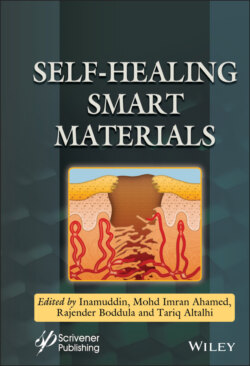Читать книгу Self-Healing Smart Materials - Группа авторов - Страница 41
3.3.6 Polyurethanes
ОглавлениеThermoplastic polyurethane (TPU) is a block copolymer consisting of alternating sequences of hard and soft segments, characterized by a high resilience and resistance to impacts, abrasion and tear. The TPU formulation includes diisocyanates, polyols, and chain extenders. The type and proportion of each of them have a significant influence on the final properties of the material. This system exhibited self-healing ability if dynamic disulfide bonds [63–65] and hydrogen bonding [66, 67] were introduced in its structure.
Based on these characteristics, several self-healing TPU elastomers have been designed by introducing dynamic covalent bonds and non-covalent interactions into the chains. Mainly, the most used mechanisms for self-healing TPU are based on dynamic disulfide bonds [68–70] and hydrogen bonding [71, 72].
Rekondo et al. [73] stated that the dynamic chemistry of disulfide bonds plays a vital role in self-healing processes. Metathesis of aromatic disulfides at room temperature is possible through the use of a tertiary amine as the catalyst. In this case bis(4-aminophenyl) disulfide was used, which is a diamine molecule characterized by an aromatic disulfide (Figure 3.26) as a dynamic crosslinking agent in poly(urea–urethane) systems. Author analyzed the use of equimolar amounts of (bis(4-aminophenyl) disulfide (1a) and bis(4-methoxyphenyl) disulfide (2) in deuterated DMSO (Figure 3.26). It was tested with 0.1 equivalents of tertiary amine (NEt3), and the equilibrium was achieved in few minutes. If the reaction is tested without NEt3, metathesis initiated in few minutes and the equilibrium is achieved in 22 h (Figure 3.26). With the aim to test that the reaction is catalyzed by primary aromatic amines present in 1a, the tests were carried out taking into account 1b and 2, without NEt3. The system reaches equilibrium in 24 h if the same amount of moles of 1b and 2 are used, confirming that a catalyst is not necessary for the exchange reaction to occur.
Figure 3.26 Reversible metathesis reaction of aromatic disulfides 1a–b and 2 (Adapted with permission from Rekondo et al. [68]).
Nevejans et al. [74] proposed the self-healing concept in coatings based on waterborne poly(urethane-urea) containing aromatic disulfide dynamic bonds. Authors expressed that self-healing coating material should present two opposite properties: i) high strength and ii) molecular mobility. The influence of the flexibility of the two aromatic disulfides and its concentration on self-healing efficiency was explored. The two aromatic disulfides are shown in Figure 3.27 being S2(Ph(CH2)3OH)2 designated as S3 and the more flexible alternative S2(Ph(CH2)6OH)2 is named S6.
The mobility of the different compounds was characterized through the relaxation time (in dynamic experiments) and the self-healing ability through the time needed for the scratch closure. It was concluded that, replacing S3 by S6 in the formulation, the mobility increase. By the other hand, it is possible to include a trifunctional amine as chain extender (instead of a difunctional one, which decreased the mobility) and even keep the self-healing ability.
Another strategy was presented by Zhang et al. [75], proposing the use of C-ON bonds in alkoxyamine to promote the self-healing action in PU composites. Based on this idea, 5-hydroxy-2-(4-hydroxy-2,2,6,6-tetramethylpiperidin-1-yloxy)-2-methyl pentanenitrile (CTPO) was proposed as a dynamic reversible molecule that contain a nitrile group bonded to C–ON moieties. Due to nitrile has the ability to absorb electrons and stabilize carbon radicals, C-ON bonds in CTPO can be activated at a lower temperature.
Figure 3.27 Chemical structure of bis[4-(3-hydroxypropyloxy)phenyl]disulfide (S3) and bis[4-(6-hydroxyhexoxy)phenyl]disulfide (S6) (Reprinted with permission from Nevejans et al. [69]).
Polyurethane was obtained through the copolymerization of CTPO with 3-isocyanatomethyl-3,5,5-trimethylcyclohexylisocyanate (IPDI) and polyethylene glycol (PEG), where PEG represent the soft block, while IPDI and CTPO are the hard segments. Figure 3.28 presents a scheme of the healing mechanism. The self-healing efficiency was measured through notched impact test. The same sample was damaged and healed up to three times, obtaining an average healing efficiency of 94.6, 91.7 and 89.8% for the first, second and third time, respectively.
Hu et al. [76] grafted a hard segment of TPU with 2-ureido-4[1H]-pyrimidione (UPy), embedding the disulfide bonds in the principal chain. UPy groups exhibits a dimerization trend that includes four hydrogen bonds in a donor–donor–acceptor–acceptor array, with rapid kinetic and high dimerization energy.
The robust interaction between quadruple H-bonding of the UPy side groups acts as supramolecular crosslinking points allowing the improvement of mechanical properties in the TPU elastomer. The self-healing abilities was characterized by a dumbbell-shaped sample, who was fully cut in half and cured at 100 °C for 2 h. After the applied healing procedure, it was not possible to find the original crack, suggesting that the structural integrity was recovered.
Figure 3.28 Schematic diagram of the healing reaction in PU (Adapted with permission from Zhang et al. [70]).
